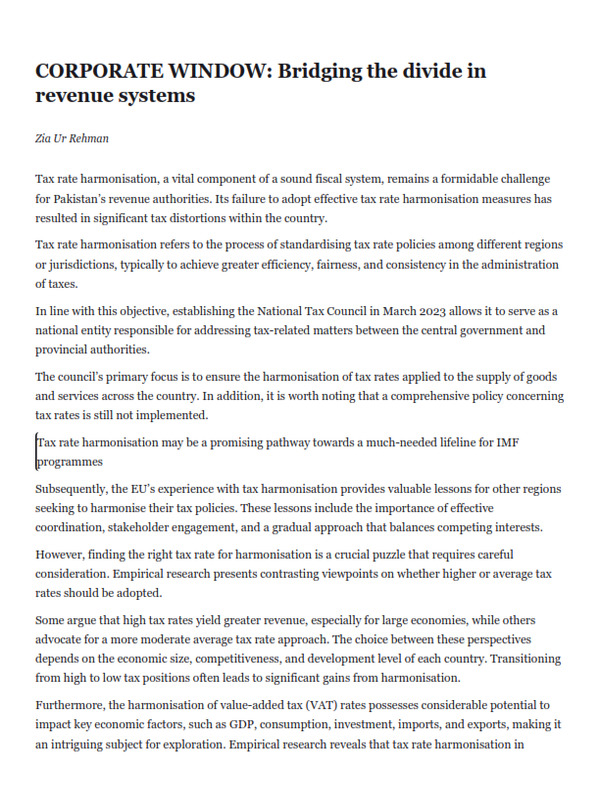
Pakistan Institute of Development Economics
- Home
Our Portals
MenuMenuMenuMenuMenuMenuMenu - ResearchMenuMenuMenuMenuMenuMenuMenu
- Discourse
- The PDR
- Our Researchers
- Academics
- Degree Verification
- Thesis Portal
- Our Portals
CORPORATE WINDOW: Bridging the divide in revenue systems
Tax rate harmonisation, a vital component of a sound fiscal system, remains a formidable challenge for Pakistan’s revenue authorities. Its failure to adopt effective tax rate harmonisation measures has resulted in significant tax distortions within the country.
Tax rate harmonisation refers to the process of standardising tax rate policies among different regions or jurisdictions, typically to achieve greater efficiency, fairness, and consistency in the administration of taxes.
In line with this objective, establishing the National Tax Council in March 2023 allows it to serve as a national entity responsible for addressing tax-related matters between the central government and provincial authorities.
The council’s primary focus is to ensure the harmonisation of tax rates applied to the supply of goods and services across the country. In addition, it is worth noting that a comprehensive policy concerning tax rates is still not implemented.
Tax rate harmonisation may be a promising pathway towards a much-needed lifeline for IMF programmes
Subsequently, the EU’s experience with tax harmonisation provides valuable lessons for other regions seeking to harmonise their tax policies. These lessons include the importance of effective coordination, stakeholder engagement, and a gradual approach that balances competing interests.
However, finding the right tax rate for harmonisation is a crucial puzzle that requires careful consideration. Empirical research presents contrasting viewpoints on whether higher or average tax rates should be adopted.
Some argue that high tax rates yield greater revenue, especially for large economies, while others advocate for a more moderate average tax rate approach. The choice between these perspectives depends on the economic size, competitiveness, and development level of each country. Transitioning from high to low tax positions often leads to significant gains from harmonisation.
Furthermore, the harmonisation of value-added tax (VAT) rates possesses considerable potential to impact key economic factors, such as GDP, consumption, investment, imports, and exports, making it an intriguing subject for exploration. Empirical research reveals that tax rate harmonisation in countries with lower VAT rates may witness a decline in consumption due to the requirement for higher rates to achieve harmonisation.
The relationship between the harmonisation of indirect taxes and GDP is evident, with most estimated models indicating negative interrelations. Notably, this study emphasises that the immediate deduction of VAT on the purchase of investment assets can contribute to such negative interrelations between indirect taxes and investments.
However, it is essential to recognise that harmonisation exerts both direct and indirect effects on investments, which are influenced by various factors.
Studies indicate negative interrelations between investment and the immediate deduction of VAT on asset purchases
Additionally, the impact of harmonisation on imports generally yields favourable outcomes for larger countries by reducing trade barriers. However, for smaller countries, the situation can be more complex and contingent upon specific circumstances. The relationships between exports and harmonisation variables exhibit diverse patterns with prevailing positive impacts.
In this regard, a comprehensive comparative analysis was conducted to examine the tax rate policies of various revenue authorities, focusing on the non-harmonisation aspect, namely the Balochistan Revenue Authority (BRA), Punjab Revenue Authority (PRA), KP Revenue Authority (KPRA), and Sindh Revenue Board (SRB). This study provides a detailed breakdown of tax rates across different sectors.
One interesting finding is that the telecom sector is subject to a 19 per cent tax rate by all authorities due to its well-established structure and widespread reach. The sector’s formalised framework makes it easier for authorities to achieve their revenue targets. The study shows that BRA and SRB have a significantly higher number of tax lines 254 and 212, while PRA and KPRA have 70 and 47, respectively.
In addition to the aforementioned observations, it is also evident that the complexity of tax rates — detail description — varies across different revenue authorities. KPRA has the highest level of complexity in most sectors, followed by PRA. Moreover, BRA has specified a fixed amount of tax, which is Rs3,000 and Rs7,000 in the restaurant sector, which is not visible in other authorities.
An intricate examination of non-harmonisation becomes apparent in the case of “wita” or “Without input tax adjustment” wherein a taxpayer is unable to offset or deduct the input tax paid on purchases from their output tax liability. Notably, this analysis unveils that the PRA applies the lowest zero-rated wita in the entertainment, medical consultation and insurance sectors.
KPRA levies a rate of 1pc wita in the broadcasting, underwriter, auctioneer and installation of equipment sectors, and BRA has 6pc wita for restaurants, and professionals and consultants sectors. SRB charges 13pc in other sectors. Moreover, KPRA offers wita to most sectors, following the approach of PRA.
These variations in tax rate policies among different revenue authorities highlight the need for tax harmonisation. This would lead to efficient tax collection and enforcement, resulting in higher government revenues and reduced burden on taxpayers.
It is crucial to acknowledge that the strength and precision of interrelations between tax rate harmonisation and economic factors exhibit notable variations across countries, underscoring the profound impact of specific factors and unique dynamics within each nation.
The current crisis has severely affected our country’s fiscal stability, necessitating innovative strategies to restore economic equilibrium. Tax rate harmonisation may stand as a promising pathway towards a much-needed lifeline for the forthcoming International Monetary Fund programmes and also lays the groundwork for a transformative legacy that will shape our nation’s future.
The writer is a research assistant at the Pakistan Institute of Development Economics, Islamabad
Published in Dawn, The Business and Finance Weekly, July 10th, 2023



